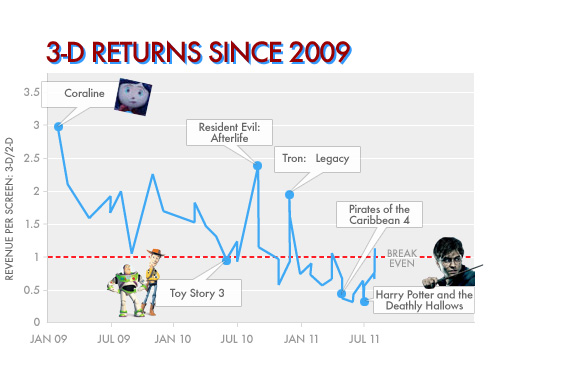Is the 3d film craze finally coming to an end?
With films like Avatar smashing all box office records, and a massive influx of mega budget 3d films hitting the multiplexes up and down the country, one would be forgiven for thinking that the dawn of 3D as an established film medium has well and truly arrived. Indeed, Jeffrey Katazenburg, one of the co founders of the giant film studio Dreamworks, went even further, publically stating that “2D films are going to be a thing of the past”.
Katzenburg’s predictions seemed to be coming true as the first wave of Post Avatar 3D films such as Alice in Wonderland, Clash of the Titans and Toy Story 3 earned enormous box office revenues. The ‘kerching’ of cash registers and the obvious sounds of hands being rubbed with glee, could be heard emanating from the boardrooms of the various Film Studios. However, by the end of August 2010, the sounds of joy was soon replaced by an air of uncertainty.
Things were not looking too rosy as the next wave of 3D films produced disappointing box office results with films barely breaking even on their 3d screenings. And, to add further salt to the proverbial wound, the latest figures released by the New York Times, has only served to reiterate the belief that the 3d medium is in desperate peril. At its height, an average 3d film was earning 70-100 percent more in cinemas than the equivalent 2d film.
However, the first clear sign of danger came the weekend of June 18, 2010. Toy Story 3 opened with $110.3 million in ticket sales, making it one of the most successful films in history. Yet the Pixar movie’s 3-D screenings contributed relatively little to its dazzling profits. Their per-cinema revenue was at minus 5 percent compared to 2-D showings, the first time in recent history that 3-D had sunk below the break-even point on a film’s first weekend. Six weeks later, Cats & Dogs: The Revenge of Kitty Galore opened with $12.3 million in total sales, and a 3-D “bonus” of minus 10 percent. The monster profits from 2009 had all but disappeared by the end of the summer.
Shares in DreamWorks Animation, the studio managed by Jeffrey “2-D films are going to be a thing of the past” Katzenberg,were in free-fall and Shares of RealD, one of the big players in stereo projection technology, have also been in a tailspin, losing 70 percent of their value since May.

It is interesting to note that Coroline, Resident Evil and Tron were all filmed using 3d Cameras and were not cheap 3d Conversions
But the 64 million dollar question is, who is responsible for the alarming slide in the popularity of 3d films.? I believe there are 3 main culprits…
1. Greedy Cinema chains : In the spring of 2010 , Regal, AMC and other large Cinema chains increased the price of 3d films by 20 % in the hope of cashing in on the 3d craze. Accountants Price Waterhouse carried out their own investigation and concluded that the 3d ticket prices were indeed overpriced. They commented that “Industry players risk killing a golden goose by overselling and, in some cases, overpricing the 3-D experience” and in a recent study, over 75% of people interviewed felt that the 3d is not worth the extra £4 per ticket.
2. Greedy Film Studios : The production costs of a 3d film far outweigh those of a conventional 2d film. As a result, the studios are shooting a lot of their films in conventional 2d and then during the post production stage they are converted to 3d. This is a cheap, shoddy method which no doubt creates a sub standard 3d experience for the punter who has forked out top dollar expecting a full 3d experience. James Cameron, the director of Avatar moaned “you got people who are quickly converting films from 2d to 3d, which is not what we did. They’re expecting the same result, when in fact it they will work against the adoption of 3D because they will be putting out an inferior product”
3. Shrewd consumers : A lot of people simply have no interest in watching 3D films, Others have suffered nausea inducing headaches and indeed a recent study suggested that 10 % of the population are actually anatomically incapable of seeing 3D effects.
To suggest that the 3d patient is dead, is a bit premature, but certainly, the post Avatar love affair with 3d has definitely soured. With Spielberg’s TinTin, already released and Scorcese and Peter Jackson, also releasing films in 3d, it will be interesting to see if the patient will make a full recovery.
